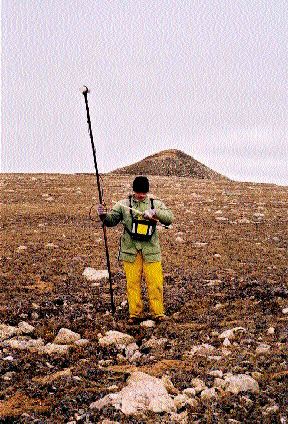After a summer’s drilling on the High Arctic Blue Ice project at Victoria Island, there appear to be more questions than answers for
Both the Carina and newly discovered Fornax kimberlites had large geophysical signatures, but drilling intersected only narrow dyke-like intervals of kimberlite. Last year, Diamonds North partially tested the Carina body with three holes, which ended prematurely while still in kimberlite, owing to difficult ground conditions. A 23.69-kg sample collected from an upper soft and intensely clay-altered portion of the Carina kimberlite delivered only eight microdiamonds. A more competent, medium-grained, olivine-rich lower phase yielded 78 diamonds in 68.72 kg of sample, including one stone exceeding 1 mm in two dimensions. Carina has a geophysical signature measuring 265 by 140 metres.
This year, Diamonds North completed one follow-up angle hole into Carina that intersected just 3.4 metres (true width) of kimberlite; only three micros were recovered from 15.94 kg of core. A detailed look at the diamond-size distribution, using square mesh sieve sizes, is provided in the accompanying table.
The Fornax kimberlite dyke was discovered 1 km southeast of Carina in the central portion of the 20-km-long Galaxy trend, which straddles the border of the Northwest Territories and Nunavut. Two angle holes tested the 240-by-100-metre geophysical anomaly, intersecting three narrow kimberlite dykes, with the main body measuring 1.3 metres (true width).
A composite 28.18-kg sample of Fornax, described as a macrocrystic olivine-rich hypabyssal kimberlite, returned 16 microdiamonds, including one stone caught on the +0.850-mm sieve that measured 1.28 by 1.08 by 0.87 mm.
Diamonds North says further work is needed to understand the relationship between the large geophysical signatures and the narrow dyke-like bodies intersected.
On the southeastern end of the Galaxy trend, Diamonds North re-tested the Vega kimberlite dyke system with one angle hole that was drilled downdip of the structure to obtain a larger volume of sample. The main V1 dyke at Vega measures 3.8 metres (true thickness), and is 11 metres north of the V2 kimberlite dyke (1.6 metres true width). Both dykes are described as olivine macrocrystic hypabyssal kimberlite containing mantle-derived indicator minerals. Eight other kimberlite dykes, six up-section of V1/V2 and two between V1 and V2, were encountered in the hole. The thickness of these other dykes ranged from 1 cm to 0.45 metre.
The V1 dyke delivered a high microdiamond count of 78 stones in a 44.6-kg sample but showed a weaker tendency towards larger stones. The biggest diamond measures 1 by 0.74 by 0.56 mm and was the only one caught in the 0.6-mm sieve size. A separate, 24-kg sample of V2 yielded 18 micros, with just one stone falling on the +0.425 mm sieve. By comparison, in 2002 at Vega, 22 micros were recovered from a 22-kg sample, and just three diamonds were large enough to remain on the +0.3 mm screen.
Caustic fusion analysis on smaller samples from two other Vega dykes, weighing 13.38 kg and 1.96 kg apiece, turned up a single micro in each sample.
This year’s exploration on the Blue Ice project is being jointly funded by
BLUE ICE 2003 MICRODIAMOND RESULTS
| Sieve Size | Carina #Diamonds | Fornax #Diamonds | Vega V1 #Diamonds | Vega V2 #Diamonds |
| +1.180 mm | 0 | 0 | 0 | 0 |
| +0.850 mm | 0 | 1 | 0 | 0 |
| +0.600 mm | 0 | 0 | 1 | 0 |
| +0.425 mm | 0 | 1 | 2 | 1 |
| +0.300 mm | 0 | 0 | 6 | 2 |
| +0.212 mm | 1 | 0 | 16 | 5 |
| +0.150 mm | 0 | 7 | 23 | 7 |
| +0.100 mm | 2 | 7 | 30 | 3 |
| Total Diamonds | 3 | 16 | 78 | 18 |
| Sample Wt. (kg) | 15.94 | 28.18 | 44.6 | 24 |


Be the first to comment on "Blue Ice proves puzzling"